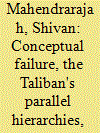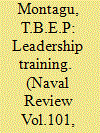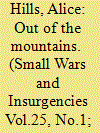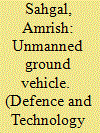| Srl | Item |
| 1 |
ID:
131467


|
|
|
|
|
| Publication |
2014.
|
| Summary/Abstract |
ISAF exists to protect the Afghan constitutional model. This strategic objective will be defeated because the GIRoA model has a conceptual flaw that renders it incapable of delivering governance at the local level (Tier IV). This fatal flaw has enabled the Taliban, by developing parallel hierarchies, to displace GIRoA and establish itself in southern locales as the political authority. The Taliban are fighting a revolutionary war, a Maoist displacement strategy that uses guerrilla tactics to advance a political program. Petraeus and McChrystal failed to recognize the character of war, and believed the Taliban are pursuing an exhaustion strategy. They failed to devise a counter-RW strategy. The 'Surge' was doomed ab initio
|
|
|
|
|
|
|
|
|
|
|
|
|
|
|
|
| 2 |
ID:
129650


|
|
|
|
|
| Publication |
2014.
|
| Summary/Abstract |
Among the most distinctive features of US President Barack Obama's counterterrorism strategy has been his reliance on unmanned aerial vehicles-more commonly known as drones-to target terrorist operatives around the globe. The use of drones has rapidly expanded beyond the battlefields where US troops have openly engaged in conflict, such as Afghanistan and Iraq, to a range of undeclared combat zones, including Pakistan, Yemen, and Somalia. According to an official estimate, the US military launched in 1,160 drone strikes in Afghanistan alone between 2009 and 2012.
|
|
|
|
|
|
|
|
|
|
|
|
|
|
|
|
| 3 |
ID:
128672


|
|
|
|
|
| Publication |
2013.
|
| Summary/Abstract |
An article written by the RN's exchange officer at the Royal Military Academy Sandhurst who deployed to Kabul as part of a mentor team for the Afghan National Army Officer Academy (ANAOA). The project is set to be the UK's enduring commitments to Afghanistan after the 2014 drawdown. The author highlights the challenges of the project from the political level through on the ground mentoring.
Leadership training
|
|
|
|
|
|
|
|
|
|
|
|
|
|
|
|
| 4 |
ID:
131473


|
|
|
|
|
| Publication |
2014.
|
| Summary/Abstract |
Afghanistan has been the defining experience of conflict for many Western militaries, so it comes as no surprise that Out of the Mountains begins with an account of the author watching a patrol fight its way out of an ambush in a remote valley in Afghanistan. But, rather than projecting this experience as the future course of conflict, David Kilcullen argues that wars in mountainous, landlocked places such as Afghanistan will become increasingly rare. In the future, most conflicts will take place in the urban littoral because that is where most people live.
|
|
|
|
|
|
|
|
|
|
|
|
|
|
|
|
| 5 |
ID:
129329


|
|
|
|
|
| Publication |
2012.
|
| Summary/Abstract |
much have been written about unmanned aerial vehicles (UAVs), unmanned combat aerial vehicles (UCAVs) and occasionally even about unmanned underwater vehicles (UUVs) but it appears not enough attention bas been paid to unmanned ground vehicles (UGVs) even though these have the maximum potential in today's counter insurgency and battlefield applications. UAVs and UGVs have both received a major boost over the last few years thanks to the conflict in Afghanistan. Many new versions have been tested, some rejected and many concepts and operational practices evolved.
|
|
|
|
|
|
|
|
|
|
|
|
|
|
|
|